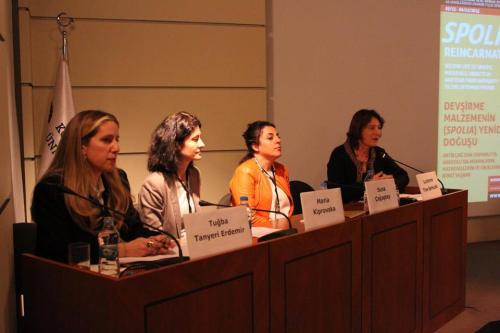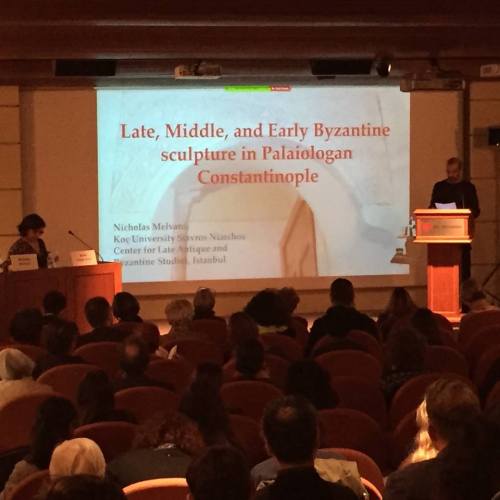
Chiara Bordino, ANAMED Fellow 2013–2014
ANAMED’s 10th International Annual Symposium (Spolia Reincarnated. Second life of spaces, materials, objects in Anatolia from Antiquity to the Ottoman period), organized by Ivana Jevtic and Suzan Yalman and held at ANAMED on 5–6 December 2015, offered a valuable opportunity to reconsider and discuss a wide topic in Anatolian Studies, namely spolia and the reuse of material and artworks from the Antiquity to the Ottoman era. Leading international scholars and several former fellows of the Research Center for Anatolian Civilizations took part in the symposium and provided a deep and articulate debate on topics presented by the speakers.
On the ‘biography’ of monuments: Professor Finbarr Barry Flood highlighted the necessity to consider the “biography” of monuments and artworks in order to get a proper understanding of the notion of spolia. Indeed, each monument or object can be looked at as a palimpsest,composed of its many transformations over time.
On the term and concept of spolia: Inge Uytterhoeven offered an excursus on the use of the term spolia in Latin sources from the archaic to the imperial era. The term originally had a military meaning, indicating the spoils of war, but it was later expanded to indicate also artworks and building materials.
On the origins of the aesthetic concept of spolia: Philipp Niewöhner drew attention to monuments in the Early Medieval West and Byzantine East. In his opinion, the reuse of capitals and building materials in the Early Christian West resulted from practical reasons. Conversely, in the Eastern regions the practice had essentially aesthetic functions evident already in some Late antique civil monuments.
Some examples of spolia: Elif Keser Kayaalp analyzed the use of Early Byzantine spolia in the mosques of Diyarbakır (ancient Amid) and Silvan (ancient Mayyafariqin), both dating to the 12th century. Livia Bevilacqua proposed a comparative analysis of the use of spolia in the 13th century Byzantine empire of Nicaea and at the court of Frederick II Hohenstaufen. Scott Redford analyzed some noteworthy cases of spolia in the Seljuk era in Anatolia and other Eastern regions.
On different modes and motives of reuse in Anatolia: Suna Çağaptay focused on the use of the double headed eagle in different cultures (Seljuks, Artuqids, Byzantines, Siculo Normans, Fatimids) and media. Maria Kiprovska investigated the architectural patronage of Mihalgullari, an aristocratic family of the Early Ottoman era, in some border lands. Tuğba Tayneri Erdemir analyzed the life of Byzantine churches in Anatolia in the post-Byzantine age, from the Ottoman conquest to the current era.

On spolia and reuse practices in Byzantine and Ottoman Istanbul: Alessandra Guiglia and Claudia Barsanti presented some examples of reuse in Hagia Sophia. Nicholas Melvani discussed the reuse of Early Byzantine capitals and pieces of sculptures in Palaiologan Constantinople. Ünver Rüstem investigated the combination of Byzantine legacy and Western fashion in the Ottoman architecture of Istanbul in the 18th century (Ottoman Baroque).
On mobile objects and their reuse as spolia: Konstantina Karterouli examined the use of Byzantine and Byzantinizing artworks in Veneto (northeastern Italy) and in the Rhine region in the 13th century. Elena Papastavrou and Nikolas Vryzidis analyzed the reuse of liturgical textiles in the Greek Orthodox Church in the Ottoman Era. Pagona Papadopoulou investigated the literary and archaeological evidence related to the reuse of Late Antique and Medieval coins.
On the three main reasons behind the phenomenon of reuse: In his summary remarks, Professor Magdalino emphasized three primary explanations for the occurrence of spolia: functional (reuse of building materials for practical reasons); aesthetic (reuse of spolia for decorative and aesthetic purposes); and intellectual and ideological (reuse of spolia to communicate religious and political messages).

